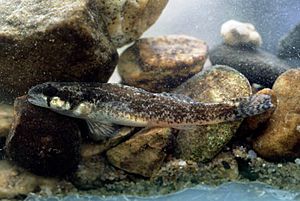Trispot darter facts for kids
The trispot darter (Etheostoma trisella) is a small, freshwater fish that belongs to a group called "ray-finned fish." This means its fins are supported by bony rays. It's a type of darter, which is a small fish known for darting quickly from place to place. The trispot darter is part of the Percidae family, which also includes well-known fish like perch.
This special fish is found only in certain areas, mainly in northern Georgia and southern Tennessee in the United States. It lives in the Conasauga River and its smaller streams. In the past, it also lived in the Alabama River system.
The trispot darter needs two different but connected places to live. When it's not breeding, it prefers the edges of the main river where the water moves slowly. These spots usually have a mix of silt and gravel on the bottom, with lots of plants. When it's time to breed, the fish moves to warmer water with a clay bottom and even more plants.
Sadly, the number of trispot darters is going down. This is mainly because their homes are being lost due to things like building dams (stream impoundment) and new land development. Because of this, the International Union for Conservation of Nature has listed the trispot darter as "vulnerable", meaning it needs protection to survive.
Quick facts for kids Trispot darter |
|
|---|---|
 |
|
| Conservation status | |
| Scientific classification |
Contents
Where Does the Trispot Darter Live?
The trispot darter is a unique fish found only in the Conasauga River and its connecting streams. These rivers are located in northern Georgia and southern Tennessee.
For a while, people thought this fish had disappeared completely from its original areas. It was even believed to be extinct for seven years! But then, in 1967, a trispot darter was found again in north Georgia. Historically, this fish lived in the Alabama River system and as far south as the Coosa River. It was also found in some other rivers in Georgia and even in a reservoir called Lake Weiss.
However, recent searches for the trispot darter haven't been very successful. Today, it is mainly found only in the Conasauga River and in Big Canoe Creek in Alabama. The main reason for this shrinking living area is thought to be human activities and development. Things like silt (fine dirt) in the water can harm the fish's eggs. Also, the water needs to be just the right temperature for the fish to breed successfully. The Conasauga River is very important because it still offers the undisturbed home that this fish needs.
What is the Trispot Darter's Home Like?
The trispot darter needs two different types of homes that are connected. When it's not breeding, it lives in the quieter parts of the main river. Here, the water moves slowly, and the river bottom is made of silt and gravel, often covered with plants.
When it's time to breed, the fish moves to warmer water. The best temperature for their eggs to grow is around 12 degrees Celsius (54 degrees Fahrenheit). Their breeding spots usually have a clay bottom and lots of thick plants growing in the water.
What Does the Trispot Darter Eat?
Scientists have studied what trispot darters eat by looking at their stomach contents. They found that about 70% of their diet is made up of tiny insect larvae called Chironomidae larvae. Another 19% of their food comes from mayfly nymphs (young mayflies).
The trispot darter shares its home with several other fish species. These include the central stoneroller (Campostoma anomalum), the southern studfish (Fundulus stellifer), and the Coosa darter (Etheostoma coosae). The Coosa darter is the main competitor for the trispot darter. This is because both fish have similar mouth sizes and body lengths, which means they might compete for the same food and living space.
The main natural enemies of the trispot darter are larger fish from the black bass family, like those in the genus Micropterus. On average, a trispot darter is about 35 millimeters (about 1.4 inches) long.
Life Cycle and Reproduction
The trispot darter usually lives for about 2.5 years.
They start to lay their eggs, a process called spawning, between January and March. During this time, the skin of the male darters becomes very brightly colored. This bright color is thought to help them attract mates. A female trispot darter can lay anywhere from 50 to 300 eggs at a time.
How We Can Help the Trispot Darter
The trispot darter is currently listed as an "Endangered" species, and its numbers are still going down. The biggest reasons for this decline are the loss of its natural home. This happens because of land development, where natural areas are built on, and also because of stream impoundment, which means building dams that change the flow and habitat of rivers. Protecting these vital river habitats is key to helping the trispot darter survive.
See also
 In Spanish: Etheostoma trisella para niños
In Spanish: Etheostoma trisella para niños


